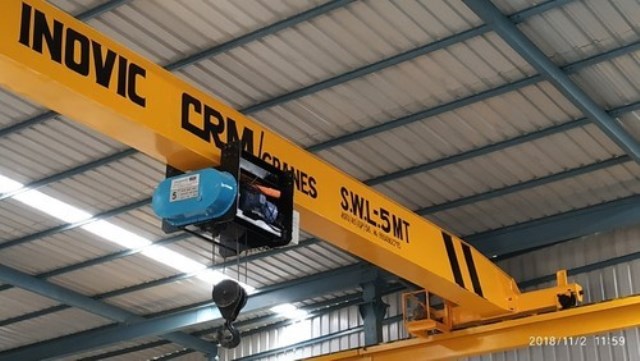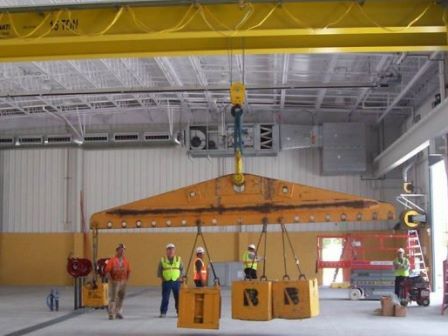The specifications depend on the essential terminology when using overhead cranes, each part, part layer, must be defined and specified. The electrical system, height, load capacity (5 tons, 10 tons, 20 tons), are specific to each crane and you must answer questions such as:
- In normal operations, the maximum load that will be placed on the structure of a crane is?
- A basic overhead crane will have at least how many moves?
- A sound or other effective audible warning signal must be provided, for which types of cranes?
- What is the capacity of a crane?

Crane Capacity
The rated capacity of the crane is the maximum working load that can be lifted.
Crane capacity is stated in US tons or metric tons and is required by code to be marked on each side of the crane and hoist; and if the crane has more than one lifting unit, each hoist must have its nominal load marked.
Please note that the load block, hook and ropes are not included in the rated load.
If the crane is intended to be used in conjunction with a magnet, “C” hook, grab, or any other device, the deadweight of such device must be specified so that the safe working load of the crane can be properly determined.
OSHA regulations state that the crane must not be loaded beyond its rated load, except for testing purposes. The load test shall be carried out at or near 125% of the rated load.
Rated working load limit
Caution: never choose more than the rated working load limit (WLL) as many factors go into the design of a crane and one must take into account the safety factor of all components such as wire rope, motors, bearings, pulleys. , drums, wheels, rails, lifting speeds and sizes of beams and steel. On many cranes this will print as the safe working load (SWL).
Electrical Requirements
Ideally 480 volts, 3 phase, 60 hertz for US requirements.
The runway power is usually by a conductor bar, and a hoisting trolley by festoon cable. The control circuit voltage at pendant push buttons shall not exceed 150 volts for AC and 300 volts for DC.
Long travel
‘Long travel’ is the direction of travel of the bridge along the rails.
Cross travel
‘Cross travel’ is the movement of the ‘crab’ from one side of the bridge to the other.
Hook Height
Hook height is the distance from the reference point to the highest position of the hook.
This dimension is essential in most applications, since it determines the height of the track from the ground and depends on the internal free height of the building. The effective lift is the distance between the beam and the floor, minus the height of the hoist.
Runway Height
The distance between the grade level and the top of
the rail.
Side Clearances
Side clearances are measured from the center of the supporting rail to the face of the supporting column and are required for operation, safety and wheel maintenance.
Vertical Clearances
The crane must be able to travel within the building while avoiding obstructions in the building such as lights, equipment, and structural framing.
The vertical clearance is based on the size of the crane bridge, location of the hoist and trolley, rail and safety allowance. The lower the crane headroom is, the higher will be the vertical clearance and the lower could be the building height.
Clear span
The span of the crane is the horizontal center distance between the rails of the runway on which the crane is to travel. Typically the distance is approximately 500 mm less than the width of the building.
How much span a crane requires depends on the crane coverage width dictated by the application. Crane coverage is the horizontal crane coverage and is defined as the crane span less the left side hook approach and right side hook approach.
Runway Length
The longitudinal run of the runway rail parallel to the length of the building.
Hook approaches
The maximum hook approach is the distance from the wall to the nearest possible position of the hook. The smaller the distance, the better will be the floor area utilization.
End Approach
This term describes the minimum horizontal distance parallel to the runway, between the outermost extremities of the crane and the centerline of the hook.
Crane speed calculation
Bridge, Trolley and Lift Speeds: The speed at which the bridge or trolley travels or the hoist is raised is usually specified in feet per minute or FPM.
Crane operating speeds are selected to allow safe operation while using the pendant.
Dual operating speeds are normally used, typically a fast and slow speed with a 4:1 ratio, but for optimum control, a variable speed control system is preferred.

What is Overhead Crane?
Overhead cranes can come in many shapes and sizes, so if you’re not certain of the terminology it’s best to start by asking: what exactly is an overhead crane?

Overhead Crane parts description
Overhead crane equipment parts can be broken down into four main categories.

Overhead Crane Safe Work Procedure
What happens when there are structural defects in an overhead crane?
